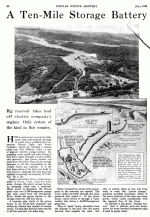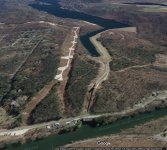HVDC is there to store the energy produced by renewable sources.
You can't always satisfy load demand and it (cable) holds energy for some time, converted to AC with static converters it is implemented to the ordinary systems used by consumers.
You can't always satisfy load demand and it (cable) holds energy for some time, converted to AC with static converters it is implemented to the ordinary systems used by consumers.
It's about economics, technology, safety, politics and history.
Electric power distribution - Wikipedia
Electric power distribution - Wikipedia
Are you suggesting that the actual cable (wire) stores electricity? If so, that is quite incorrect. Unfortunately, cables don't store energy (it would make life much simpler for electric car engineers if they did!)...it (cable) holds energy for some time...
If we are being very pedantic, yes, thousands of kilometres of high-voltage DC cable will store a microscopic amount of energy, because of its capacitance. But this is such a tiny amount of energy that this is utterly irrelevant for the purposes for which such cables are used - transmitting hundreds of thousands, maybe millions, of watts.
Energy storage to compensate for erratic wind and solar power is done in several ways. One that's becoming more common recently is to build an enormous lithium battery, as Tesla recently did in Australia: Tesla's giant battery in Australia made around $1 million in just a few days - Electrek
An older system is to use excess energy to pump water uphill (up an existing dam where hydroelectric power is being generated), and later retrieve that energy from the falling water as usual.
Tesla's gigantic lithium batteries are now showing up in California as well: Tesla’s Megapack battery is big enough to help grids handle peak demand - The Verge
-Gnobuddy
One thing we are not short of in Scotland is water and I must give a plug (pun intended!) to the pumped-storage hydroelectric power station in Argyll and Bute which has been operating since 1965.An older system is to use excess energy to pump water uphill (up an existing dam where hydroelectric power is being generated), and later retrieve that energy from the falling water as usual.
Cruachan Power Station - Wikipedia
Attachments
Wow, I had no idea that idea had been implemented that long ago. Thanks for that!...pumped-storage...since 1965.
-Gnobuddy
> I had no idea that idea had been implemented that long ago.
In 1965, it was proposed to use Sunfish Pond in New Jersey for pumped storage. (Possibly inspired by the Scottish installation.)
This was a side-thought to the Tocks Island Dam controversy.
See also: Pumped-storage hydroelectricity - Wikipedia
See also attached. The pipe is still there.
Rocky River Pumped Storage Hydraulic Plant | ASCE
Firstlight's Facilities - First Light Power Resources
In 1965, it was proposed to use Sunfish Pond in New Jersey for pumped storage. (Possibly inspired by the Scottish installation.)
This was a side-thought to the Tocks Island Dam controversy.
See also: Pumped-storage hydroelectricity - Wikipedia
See also attached. The pipe is still there.
Rocky River Pumped Storage Hydraulic Plant | ASCE
Firstlight's Facilities - First Light Power Resources
Attachments
Last edited:
@Gnobuddy
you didn't understand what was the meaning of some time, also you don't understand meaning of capacitance in electrical circuit...
you didn't understand what was the meaning of some time, also you don't understand meaning of capacitance in electrical circuit...
To be fair Pitbul, I reckon he knows what he talls about...
What you refer to is polarisation of insulation due to HVDC. This charge is not the same as storage of Power.
What you refer to is polarisation of insulation due to HVDC. This charge is not the same as storage of Power.
In the home? Interesting.. We also have separate cooking circuits but just to support 15A. 10A is normal for outlets.Cooking and heating is done with 240V.
Isn't the higher Voltage statistically more likely to produce correctable fibrillation upon electrocution?Its a compromise between efficiency, thickness of cables and safety.
In the UK it is 230VAC whcih is efficient and needs less thick cable but that voltage kills.
In the USA its 110VAC which is not quite so dangerous but you need thicker more expensive cable to carry the extra current.
@mondogenerator
HVDC cable will stabilize a network against disturbances due to rapid changes in power, is my goal.
Also, HVDC cable stores energy, not power. You don't recognize power and enrgy meaning.
HVDC cable will stabilize a network against disturbances due to rapid changes in power, is my goal.
Also, HVDC cable stores energy, not power. You don't recognize power and enrgy meaning.
Cables dont store energy nor power. `HVDC stabilize the power grid as they do not suffer from AC phase shifts when power demand is changing rapidly as is the case in AC grids. As soon as there is more than one AC power generator feeding the grid exact phase sync between all generators on the net is absolutely mandatory. They must run in exactely the same absolute 50/60 Hz phase. And in todays grids, there are hundreds to thousends of power generators on grids that span whole continents. If one is out of sync, all others will pump enormous amounts of power into this one creating a nice firework.
@mondogenerator
HVDC cable will stabilize a network against disturbances due to rapid changes in power, is my goal.
Also, HVDC cable stores energy, not power. You don't recognize power and enrgy meaning.
Haha ok. That's what I said in correction of you post.
No power is stored
I work in the power transmission industry.
The energy stored isnt power, and doesnt contribute to anything much, except parasitic losses.
It certainly doesnt stabilise the network to transient load changes
@mondogenerator
you are silly, where did I wrote power?
Also try to calculate stored energy on that high voltage direct current cable...
you are silly, where did I wrote power?
Also try to calculate stored energy on that high voltage direct current cable...
Also try to calculate stored energy on that high voltage direct current cable...
Miniscule, certainly not enough to "stabilize a network against disturbances"
The stability of the DC network has no significant benefit from cables.
aboos is correct.
In the home? Interesting.. We also have separate cooking circuits but just to support 15A. 10A is normal for outlets.
Current UK practice is 30A circuit for Double Oven plus separate 30A circuit for Induction Hob. I know because I have replaced our gas hob with an induction hob. I thought the existing outlet would power both until I read the installation instructions. 15A is not much for cooking.
Wow, I had no idea that idea had been implemented that long ago. Thanks for that!
-Gnobuddy
The Walchensee hydroelectric power station - since 1924!
Walchensee Hydroelectric Power Station - Wikipedia
Best regards!
Scotland's next Loch Ness monster could power 400,000 homes!
Plans for new pumped-storage hydroelectric schemes in Scotland have been submitted. Locations include Loch Ness and Coire Glas in the Scottish Highlands, and Glenmuckloch in Dumfries & Galloway.
Such schemes are highly efficient and improve grid reliability by balancing out fluctuations in output from wind farms and solar power schemes and promote maximum use of renewable energy.
Unfortunately such schemes are also highly expensive, running to billions of pounds. Somehow we could afford to build them in the 50s and 60s when most of the hydroelectric schemes were built, but now have to rely on investors who demand government support via changes to energy market rules in order to provide assurance about future returns.
The UK government is said to recognise storage as a way to reduce carbon emissions, but little has yet been done to remove barriers to investment.
Plans for new pumped-storage hydroelectric schemes in Scotland have been submitted. Locations include Loch Ness and Coire Glas in the Scottish Highlands, and Glenmuckloch in Dumfries & Galloway.
Such schemes are highly efficient and improve grid reliability by balancing out fluctuations in output from wind farms and solar power schemes and promote maximum use of renewable energy.
Unfortunately such schemes are also highly expensive, running to billions of pounds. Somehow we could afford to build them in the 50s and 60s when most of the hydroelectric schemes were built, but now have to rely on investors who demand government support via changes to energy market rules in order to provide assurance about future returns.
The UK government is said to recognise storage as a way to reduce carbon emissions, but little has yet been done to remove barriers to investment.
Attachments
- Status
- Not open for further replies.
- Home
- Amplifiers
- Power Supplies
- Domestic mains voltage and frequency



